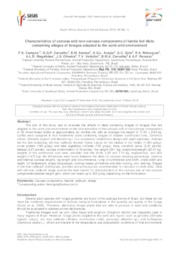Characteristics of carcass and non-carcass components of lambs fed diets containing silages of forages adapted to the semi-arid environment.
Characteristics of carcass and non-carcass components of lambs fed diets containing silages of forages adapted to the semi-arid environment.
Autoria: CAMPOS, F. S.; CARVALHO, G. G. P.; SANTOS, E. M.; ARAUJO, G. G. L. de; GOIS, G. C.; REBOUÇAS, R. A.; MAGALHÃES, A. L. R.; OLIVEIRA, J. S.; VOLTOLINI, T. V.; CARVALHO, B. M. A.; PERAZZO, A. F.
Resumo: The aim of this study was to evaluate the effects of diets containing silages of forages that are adapted to the semi-arid environment on the characteristics of the carcass and of non-carcass components of 32 mixed-breed lambs at approximately six months old, with an average live weight of 17.61 ± 2.63 kg. Lambs were assigned to four treatments (diets containing silages of Atriplex nummularia Lind, Cenchrus ciliaris, Gliricidia sepium and Manihot sp.) in a completely randomized design with eight replicates. Animals fed the diet containing old man saltbush showed higher values for the intakes of dry matter (1.080 g/day), crude protein (190 g/day) and total digestible nutrients (740 g/day), body condition score (2.81 points), fatness (2.87 points), carcass conformation (3.19 points), live weight (29.1 kg), empty bodyweight (23.41 kg), weights of the commercial cuts neck, shoulder and ribs (0.46, 0.82 and 1.12 kg, respectively), and skin weight (1.972 kg). No differences were found between the diets for carcass dressing percentage, external and internal carcass lengths, leg length and circumference, rump circumference and width, chest width and depth, full bodyweight, empty bodyweight, cooling losses, pH before and after cooling, loin, and leg. Silages of old man saltbush, buffelgrass, gliricidia and pornunça are recommended for inclusion in lamb diets. Diets with old man saltbush silage provide the best results for characteristics of the carcass and of non-carcass components besides weight gain, which can reach up to 200 g/day depending on the formulation.
Ano de publicação: 2019
Tipo de publicação: Artigo de periódico
Unidade: Embrapa Semiárido
Palavras-chave: Atriplex nummularia, Carcaça, Cenchrus ciliaris, Composição de carcaça, Confinamento, Erva sal, Forragem, Gliricidia sepium, Ovelha, Saltbush
Observações
1 - Por padrão são exibidas publicações dos últimos 20 anos. Para encontrar publicações mais antigas, configure o filtro ano de publicação, colocando o ano a partir do qual você deseja encontrar publicações. O filtro está na coluna da esquerda na busca acima.
2 - Para ler algumas publicações da Embrapa (apenas as que estão em formato ePub), é necessário ter, no celular ou computador, um desses softwares gratuitos. Sistemas Android: Google Play Livros; IOS: iBooks; Windows e Linux: software Calibre.
Acesse outras publicações
Acesse a Base de Dados da Pesquisa Agropecuária (BDPA) para consultar o acervo completo das bibliotecas da Embrapa.

